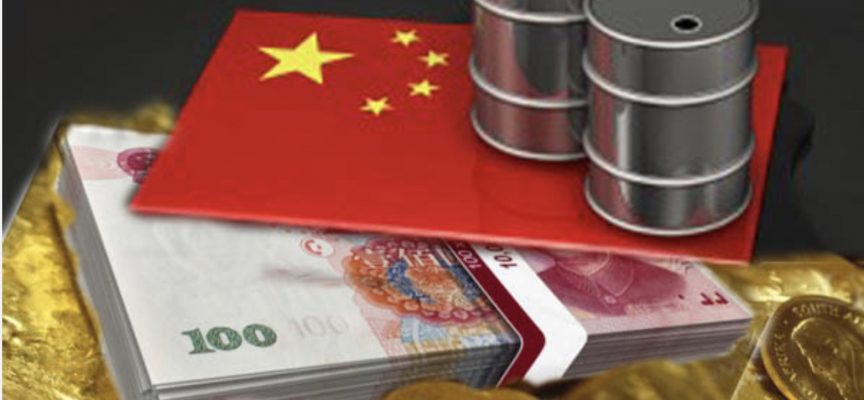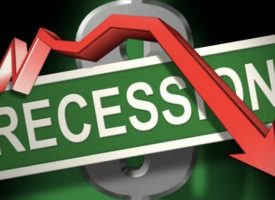Today a legend who is connected in China at the highest levels said China may peg the renminbi to gold. He also warned the next downturn is set to rival the Great Depression.
Back To The Future
By John Ing, Maison Placements
October 31 (King World News) – This economic cold war is about the future world leadership for global economic, technological, financial and geopolitical dominance. We believe that the tariff war is about Team Trump’s desire to contain China who already has taken a lead in the high-tech field and is now pushing for alternatives to US hegemony. The inclusion of an anti-Chinese poison pill notice in NAFTA 2.0 opens up a new front making the so-called free trade deal, not so free.
In fact in reshaping the world order, we believe that we are returning to the great shifting of power rivalries of the 19th Century. America is afraid of the “Thucydides’ Trap”, when ancient countries’ rivalry ended up in wars to establish which country was top dog. Work by Professor Allison from Harvard studied a 500 year period when one power threatened to displace another, that in 12 of 16 instances, they ended badly in bloodshed, including more recently the two World Wars. Today, defense spending is rising substantially everywhere and in some places breaking Cold War levels. Worrisome too is that Trump is seeking to end the 1987 nuclear treaty with Russia.
And China’s difficulty is that in this game of chicken, backing down to a public browbeating would be a loss of “face” which would resurrect a nationalist upsurge, not easy with a 1.3 billion populace. A win-win battle is increasing unlikely if the Trump Team stays the course. Needed is a compromise deal like the USMCA deal where minor concessions allowed both sides to claim a tweetable win…
ALERT:
To see the symbol for the only gold explorer in the world with no debt and a
massive treasury that has seen insiders buy more than 3 million shares
in the open market CLICK HERE OR BELOW
Shooting Themselves in the Foot
Unlike Canada, China has options and multiple fiscal and monetary levers to counter the tariff impact. To date, China’s retaliation has been muted and measured, imposing tariffs on some 5,200 products, including LNG, cocoa powder and frozen vegetables. While 70 percent of the US economy is geared towards consumption, China by contrast is only 40 percent. Therefore the American consumer will be harder hit by higher prices from this tariff war. Although parts for computer servers, smart phones, and network working gear manufactured in China face higher US tariffs, the US exempted the popular Apple watches and other consumer gadgets. However, America’s champions like Cisco Systems, Dell and Hewlett-Packard were not so lucky and have asked for exclusions or waivers. Ford Motor, America’s number 2 automaker said the tariff war will cost them $1 billion. And, despite the tariffs, US farmers’ income will drop this year.
Ironically, tariffs won’t fix the trade imbalance between China and the United States. Despite unleashing the tariff dogs, US goods’ trade deficit surged to a near high in August, plunging to $75.8 billion, as its exports fell. The value of China’s exports rose 14.5 percent in September and China achieved a record $34.1 billion surplus with the US, despite the onslaught of the trade war. China’s entire export sector accounted for less than 20 percent of China’s GDP in 2017 down from 35 percent in 2007. Exports as a percentage of China’s GDP has fallen every year for the past decade. So why the tariffs?
Tariffs Will Upset American Supply Chains
Mr. Trump believes he has the upper hand but among the bravado, the dealmaker has a losing hand. The so-called Chinese trade surplus is driven largely by the Chinese comparative advantage and global capital flows. Tariffs won’t change that. In 1960, the US represented 40 percent of global output and today that has shrunk to 20 percent. Trump’s new world will further marginalize the United States. Just as Trump didn’t expect some 100 plus world leaders at the UN General Assembly to laugh at his bragging so will he learn that his trade policy and rejection of globalism is no laughing matter.
To be sure there are other unintended consequences. For example, America’s isolationist stance already has hurt their multi-nationals’ well-developed supply chains. By contrast, China’s supply chains are largely based in the East and will be little affected by the tariff escalation. The Chinese One Belt, One Road initiative creates international supply chains to bring food, raw materials and energy back to China. In a fundamental rearrangement of those supply chains, Chinese companies have developed extensive infrastructure and logistics in nearby Philippines, Malaysia and Vietnam taking advantage of their skilled and lower priced labour. And, American companies will be at a major disadvantage with limited access to China’s huge $12 trillion economy, as the EU, Mexico and Japan are given more access.
Although, China entered the World Trade Organization (WTO) some 17 years ago, the Group of Seven countries have benefited largely from the Chinese growth locomotive. Unlike America, China is in talks with 27 countries and is even pushing for a free trade agreement with Canada. The Chinese have offset Trump’s tariffs by accelerating their exports to other markets, benefitting neighboring economies which was the destination for almost 60 percent of Chinese exports last year or more than double that of the United States (20 percent), the Eurozone (16 percent) and Japan (6 percent) combined, all in compliance within the WTO rules…
Gold is making its way back into the global monetary
system, to learn more CLICK HERE!
 Sponsored
Sponsored
Tariffs Will Boost Energy Prices
President Trump tweeted that there is an easy way to avoid a tariff war and that is for everyone to reduce tariffs. Ironically, the Chinese are doing just that and in reducing their tariffs on some imports, they also widen the gap making American goods much more expensive and less attractive. China’s tariff reductions on almost 1,500 consumer products is part of an effort to open up its economy and of course, cushion their people from the tariff increases. That move alone opens up its market to outsiders, except for the United States of course. Another unintended consequence.
Then there is the all important energy world. Mr. Trump in King Canute-like fashion tweeted that the OPEC monopoly must get prices down, accusing OPEC of “ripping off the world”. The oil price subsequently hit 4 year highs as American sanctions on Iran and Venezuela boosted prices on fears of tighter supplies ahead of the seasonal pick-up for heating.
Meantime, the Chinese slapped a 10 percent tariff on exports including American liquefied natural gas (LNG) as part of the escalating trade war between the two countries. The Chinese are the world’s fastest growing market and importer of LNG. A cessation would hurt America’s burgeoning LNG market which is flooded with cheap gas thanks to shale output. US LNG exports to China was almost nonexistent two years ago but now makes up about 10 percent of China’s total imports. The Chinese were buying $1 billion a month of American crude, accounting for 4 percent of US oil imports. Today there are reports that imports have stopped. While the world’s largest consumer of oil, has not imposed an import tax, China has purchased more from the Middle East and Russia. PetroChina signed a 22 year deal, the largest ever contract with Qatar, the world’s largest LNG exporter. In essence, Trump’s tariff war has the unintended consequence of opening the door to rival countries to fill the vacuum left by America.
Isolating the Greenback Diminishes its Role As a Reserve Currency
The gap between rising US bond yields and a sinking dollar is a confusing development. Normally higher bond yields would signal higher rates and thus strengthen the US dollar as capital inflows push it up. However with the US economy on a tear, the dollar’s pre-eminence is sinking partly due to Trump’s isolationist doctrine. We believe that there is a growing reassessment of the role of the American currency in the financial system, particularly since their road is paved with debt and more debt. Faith in the dollar has ebbed with each tariff, sanction or tweet in a slow collapse in trust, played out in public.
As Mr. Trump weaponizes the dollar to get his way, the bigger risk extends to the dollar’s hegemony. Europe, China and Russia currently make up about two thirds of international debt have challenged the dollar’s dominance. Europe and Russia are setting up a special purpose vehicle as an alternative payment system, particularly since they must pay 80 percent of their energy import bill in US dollars when only 2 percent comes from the U.S. As an alternative to the American led SWIFT payment system, China has used the renminbi for energy and iron ore swaps. China also joined the UK, Germany, France and Russia in establishing this special legal payments entity. After weaponization of the dollar and America’s withdrawal from the Iran nuclear deal, the new payment channel will allow the circumvention of US sanctions as an alternative to the American led financial hegemony, further undermining the dollar’s reserve status. Gold anyone?
This is troubling dollar holders and the cumulative effects will push up global inflation, damage the dollar’s credibility and undermine the dollar’s central role. That loss of investor confidence exposes the dollar’s vulnerability. Once before, critical of US monetary policy, a growing number of countries redeemed dollars for gold resulting in President Nixon closing the gold window in 1971. The dollar subsequently became a unique surrogate for gold and the foundation for the global monetary system. However history showed it was built on quicksand, as a series of financial booms and busts ensued. And, just as America replaced Britain as the world’s dominant economic power in the Forties, so too the large debts and fiscal pressures confronting America today, is causing America’s creditors to revisit the international monetary system and America’s hegemony.
Today, the world is flooded with dollars and market sentiment has turned a glass half empty into one that is half full. Fundamentals like a robust economy are ignored, replaced with the declining perception of America on the world stage and the realization that their chronic twin deficits and finances are in shambles. The dollar has recently dropped as America’s debtors repatriate those dollars. Noteworthy is that the International Monetary Fund (IMF) recently released a report that the dollar’s share of global reserves fell for the sixth straight quarter to the lowest level since 2013, sinking to 62.3 percent from 65.4 percent when Donald Trump took office in January 2017…
NEW KEITH NEUMEYER INTERVIEW:
Keith Neumeyer spoke with KWN about $8,000 & $10,000 price targets for gold and much more, to listen immediately CLICK HERE OR ON THE IMAGE BELOW.
 Sponsored
Sponsored
Ten Years Later
Ten years on from the collapse of Lehman Brothers and the global financial crisis that almost caused another Great Depression, there is still some debate as to whether Bear Stearns or Lehman Brothers could have survived, but they were not the reason for the crash. At one time the housing market was considered the bedrock of the American economy. However the excesses of capital, loose regulations together with the securitization of Wall Street’s derivatives interplayed with esoteric mortgage-backed securities (CDOs, MBS and CDS), which sliced and diced housing risk, inflating the housing bubble to monumental proportions. A crash then was no surprise although Wall Street almost sank by their own creations, sparking a panic as investors sought liquidity from the very institutions that created those instruments.
Those alchemists did not have enough capital and the rush for the exits created huge problems, such that the government only averted the crisis by opening the monetary spigots. The precious banking system was saved, but at a cost. Higher debt and a boost in inflation is an unintended consequence. Inflation is a dynamic animal and today, a full employment economy, $70 crude and the impact of Trump’s tariffs will give inflation a boost, reminiscent of the Seventies which ended up with double-digit prices and interest rates. This time though Mr. Volcker has retired and the record levels of government, corporate and household debt leaves newly minted Fed Chair Powell little room to maneuver.
Who Will Bail Out America?
Today, the stock market is considered the keystone of the American economy. However, fueled by greed, cheap money, and the Fed’s quantitative easing program which purchased government debt that flattened the yield curve, investors piled into housing and riskier assets, like debt and equities. Today the Fed is wisely unwinding its massive $5 trillion bond portfolio, yet Mr. Trump tweeted that the Fed was “making a big mistake”. America is ill prepared for what is to come. Debt is too high. The policy arsenal is empty from fighting the 2008 crisis. After all, how low can interest rates go? And, the Fed’s arsenal is spent with its balance sheet a whopping 30 percent of America’s GDP. Foreigners hold about 40 percent of the $15 trillion market and China’s recent absence has helped push rates up. As before the debt fueled stock market bubble has laid the seeds for the next economic downturn.
And amid the global tensions, China once the biggest buyer, has been dumping their Treasury holdings leaving $1.2 trillion. China saves more than the United States and could easily undermine the dollar by dumping its massive holdings, causing the Fed to boost rates further. Both sides are treading a fine line. Alternatively, there is the nuclear option of devaluation, letting the renminbi collapse in a throwback to the Great Depression. Since March, the renminbi has already lost almost 11 percent of its value due to a stronger greenback as Beijing allowed the currency to fall cushioning their economy from the impact of tariffs. Competitive devaluations hurts everyone because of the risk of a chain reaction of volatility which exacerbated the Great Depression.
America’s financial profligacy and penchant to consume has left the US balance sheet in shambles with debt larger than GDP. Before the subprime mortgage crisis in 2008, banks’ excess reserves were almost zero but today top $2 trillion. Debt on debt is not good. Debt service payments on America’s $21.5 trillion of debt has doubled this year to $523 billion, the highest on record.
America is a profligate spender and its deficit spending were supposed to scare the bond vigilantes who have been in denial. Until the three rate increases this year, few cared, partly because of the complacent view that the US has a monopoly in creating dollars out of the thinnest of air. This year however, Trump’s deficit grew 17 percent and next year the deficit will top $1 trillion. Mr. Trump has become a bigger spender than Mr. Obama. Ominously after bottoming below 2 percent, the yield on 10 year Treasuries have climbed above 3 percent to the highest levels since 2011 as rates continue to rise across the globe. This uptick in rates coincided with a global market crash that erased $8 trillion of value, and a buyer’s strike as foreigners sat on the sidelines in the face of an ever expanding Treasury supply. Who will bail out America? Politics today matters more than trust.
Cash is Trash
Until this month valuations were sky-high as the markets posted record highs daily. The S&P 500 only last month hit another record high, has now wiped out its gains for the year. The bull market was the longest uninterrupted bull run in history but is eerily similar to the excesses of the Twenties just before the October crash that led to the Great Depression. In Canada, cannabis stocks are not the only thing that are high. The stock market is a bubble. Rather than trade on earnings or dividends, investors are caught up in a circle of greed, believing that being out of the stock market is more hurtful to their portfolios. Cash is trash, until now…
IMPORTANT:
A legendary drill team is helping one junior gold explorer uncover a multi-million ounce gold deposit, to learn more CLICK HERE OR ON THE IMAGE BELOW
 Sponsored
Sponsored
We are concerned. To be clear, the world has changed as the US swings to isolationism. The collapse in emerging market currencies is not an isolated instance. The EU is beset by the uncertainty of Brexit and fears of an Italian budgetary stalemate could set off a Greek-style banking crisis and a slide towards default. The financial side effects only now emerging, from the pile up of US debt to higher inflation to Trump’s trade war, which only exacerbate the trend. The easy money tide that raised all ships, is reversing direction. Debt on debt is not good and the US dollar is particularly vulnerable since America remains the biggest debtor in the world. The US has become unpredictable and Mr. Trump’s penchant for bullying those who provide the capital or his creditors will hurt America. It is not so different this time. Gold is a good thing to have.
Gold Is the New as Currency
Gold has been a store of value for thousands of years. However, in the past 50 years the entire global monetary system has been anchored by the US dollar, a fiat currency backed only by the good faith and credit of the United States. The dollar is the linchpin of the global economic system. But the world’s political climate has changed, for the worst. As before, a “beggar thy nation” attitude is prevalent. The US has a serious problem with their deficits, an overvalued dollar and isolationist stance which we believe will trigger a major slide in the dollar.
The central banks from Asia and Eastern Europe have become major buyers of gold since they have too many dollars. Since 2007, Russia and China have boosted their gold holdings by 350 percent. After a 32 years absence from buying gold, Hungary too has increased their gold reserves 10 fold to 31.5 tonnes. In the first half of this year, central banks added to their stockpiles purchasing almost 200 tonnes of gold. Gold is simply an alternative to the dollar for these central banks as they diversify their reserves, the most in several decades in response to the geopolitical shift.
America’s Achilles’ heel is that they are dependent on foreign capital to finance their large fiscal deficits. America needs an inflow of money to fund their growing debts and without that, the Federal Reserve must be the buyer of last resort for Treasury securities, not unlike the Italian or Greek governments or in fact Venezuela.
China’s $3.2 trillion in reserves gives it plenty of ammunition to claim leadership in the creation of a new world order. The Chinese are not indebted to the Americans, it is the other way. In fact, China could peg the renminbi to gold, as Britain did in 1821. After all, China is the world’s largest consumer and producer of gold and China has the reserves to do this.
Gold is a good thing to have as a hedge against the inevitable collapse of the dollar. We believe those investors that have migrated to art, classic cars and collectibles will look at gold. It is undervalued. Since his election we believed the Trump presidency would be bad for budget deficits and the dollar, but good for gold. Nothing has changed.
The next downturn could rival the Great Depression. Gold was a storehouse of value then retaining its value over centuries. One can detect the decline of confidence in every part of the world. To be sure, with the growing risk of higher inflation as tariffs puts upward pressure on prices, and a world immersed in radical geopolitical confusion, gold is a good thing to have.
Gold & Gold Stocks
Gold has finally reversed its downtrend after global markets collapsed on fears of a global slowdown sparked by Trump’s tariffs and geopolitical uncertainties. In the current quarter gold fell below $1,200 an ounce, the breakeven price for many gold producers. We believe gold’s breakout was due in part to a reversal of the massive speculative short position as investors reversed a bad call on gold. Gold shares are under owned and undervalued. We also believe the bottom for gold was reached in the past quarter and the announcement of the merger of Barrick Gold and Randgold Resources was a reflection that a bottom was reached when the biggest industry player believed that another’s gold assets and bullion had reached attractive levels, enough to spend $6 billion.
***Egon von Greyerz discusses his meeting with the Chinese and what they are up to in the gold market as well as what other surprises are in store for the last two months of 2018 CLICK HERE OR ON THE IMAGE BELOW.
ALSO JUST RELEASED: This Will Create The Next Round Of Panic In Stock Markets Across The Globe CLICK HERE TO READ.
To listen to the man who worked side-by-side with the Chairman of the Comex in the 1970s and called the stock market crash of 1987 CLICK HERE OR ON THE IMAGE BELOW. What he had to say about what is coming for stocks, bonds and gold is priceless.
© 2018 by King World News®. All Rights Reserved. This material may not be published, broadcast, rewritten, or redistributed. However, linking directly to the articles is permitted and encouraged.










